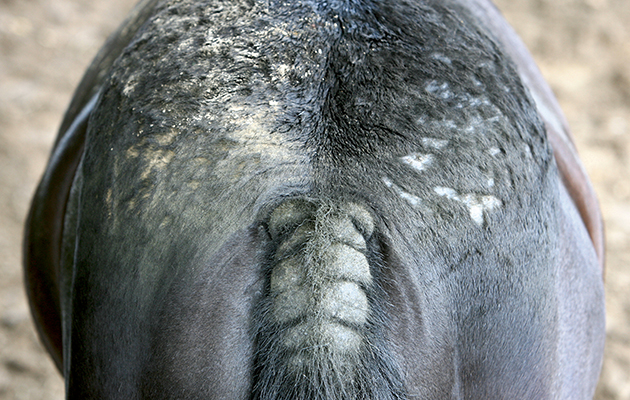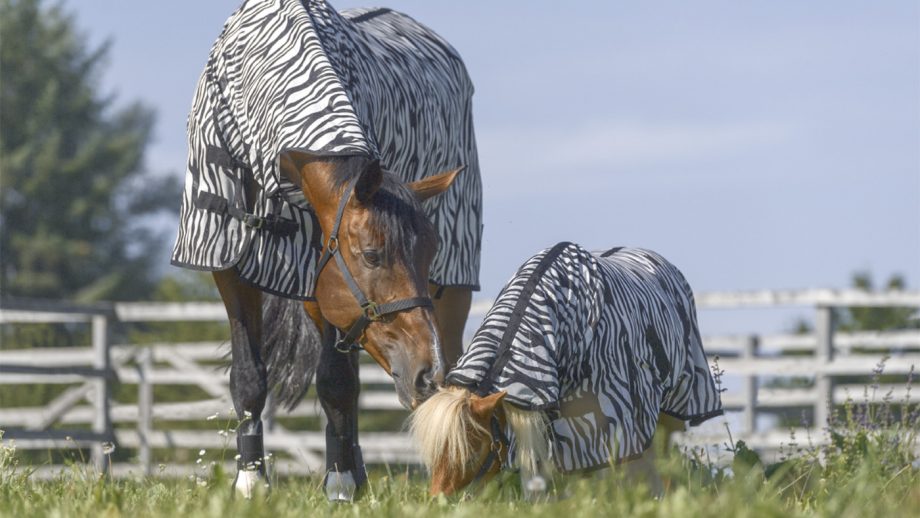Sweet itch in horses can be described as pruritus – the technical term for itchiness, the unpleasant sensation that leads horses to bite, scratch or rub at their skin. Sometimes the sensation is so strong that horses will cause severe damage to themselves or their environment, while in extreme cases, horses cannot tolerate tack on their skin, let alone a rider.
Although poorly understood, pruritus is known to result from the stimulation of special nerve endings and receptors in the skin. In the horse, the three main factors inducing itchy skin are ectoparasites (such as biting insects), allergies and some infections. Biting insects including lice, midges, black flies and horse flies can trigger cases of pruritus, but milder cases can occur simply as a horse sheds its coat.
Sweet itch in horses: Signs | Prevention and management | Treatment
In most cases a severe itch is made up of a number of smaller itches. The point at which a horse responds to an itch will vary from animal to animal and is known as the pruritus threshold. Below this threshold the horse may have potentially itchy stimuli present, but not respond to them.
One example is that a horse can carry a burden of parasites such as lice, which cause damage to the skin, without showing any clinical signs. However, once the damaged skin becomes infected, this additional level of discomfort can push the horse beyond its pruritus threshold, causing it to rub or bite itself.
Sweet itch in horses is the term for the itchiness caused by midges, which typically appears in spring and settles down to virtually disappear during the winter provided it is cold enough for the midges not to be flying, which is usually less than about 4°C. For this reason, purchasers need to be aware of the potential risk of buying a horse with no signs of skin disease during the winter which, by mid-summer, could turn into a major sweet itch case. Any signs of irregularity and discolouration of the skin, most noticeable when the coat is clipped should be viewed with suspicion. Similarly if the mane or tail are a little thin or threadbare, do not just dismiss them as a rug or hood that rubs.
Sweet itch develops when the affected horses and ponies, which are more commonly the worst sufferers, are sensitive to the irritants in midge saliva.
Typical signs
- Mild to severe itching and rubbing, usually along the mane, back and tail
- Loss of tail and mane hair
- Bald patches, which can look ugly and grey due to permanent hair loss and skin damage
- Areas of sore, open, broken skin, which tend to bleed
- In some cases, itching along the legs and under the belly
Different types of midges will attack different parts of the body, resulting in different areas of skin being affected, but true sweet itch mostly affects the mane and base of the tail, which is a clue to the identity of the problem.
Prevention of sweet itch and management of itchy horses
- A good midge repellent is essential – your vet will be able to guide you on this
- The problem can be controlled in many horses by moving to field that is away from water courses and where there is often a strong breeze
- Small areas of water can be midge breeding areas, such as water troughs, so they need to be cleaned often
- Stable your horse from about 4pm to 8am when midges are at their worst. Using insect-proof mesh on the windows and door of stables may help
- Keep your horse’s skin covered using an ear-to-tail sweet itch rug designed to help prevent midges accessing your horse. This is really important and needs to be started while the weather is still cold and the midges are not out, otherwise the sweet itch sufferer will already be itching and will shred any rug
- Use strong ceiling fans in stables as midges cannot fly against a strong air current
- Carry out medicated treatment frequently (it is often required on a daily basis), otherwise the midges will start to bite, which triggers the itch/scratch cycle
- Although there is limited research available, anecdotal evidence from owners of horses suffering from sweet itch suggests feed supplements designed to support and maintain good skin health can help
- It is hoped that in the relatively near future, vaccines may become available to make affected horses and ponies tolerant to the irritation
Investigation into the causes of pruritus should focus on the major trigger factors of parasites and allergies, while remembering that it is common for more than one problem to be present. With parasites, such as mites, reinfection is common.
The distribution of the sore areas, such as the classic rubbed mare and tail associated with sweet itch, can help identify if parasites are responsible by simple pattern recognition of the lesions present.
Skin scrapings are useful in many cases, enabling the vet to check for lice and other skin parasites, such as mange mites. A detailed dermatology examination, including biopsies of the areas of freshly damaged skin are often more informative than skin scrapings alone, however it can be hard to obtain a diagnosis on longstanding cases, especially when the skin has been coated in a variety of lotions and potions. Sometimes treatment has to be stopped to enable the vet to obtain a true picture of the problem.
Your vet may recommend further investigations to establish the precise cause of skin irritation and itchiness. This may include equine intra-dermal skin testing, which involves the intradermal injection of a range of potential allergens relevant to the geographical area. Results are scored subjectively and there may the option to consider immunotherapy depending on the results, which will work in some, but not all cases.
Treatment of sweet itch
Prevention is better than treatment, which should include all possible measures to reduce the exposure to biting insects, including the use of fully covering sweet itch rugs, fly masks and fly sprays or fly gels.
Steroids can be used to combat the irritation, but unless they are accompanied by treatment for the underlying cause of the pruritus, a relapse is likely. They may be beneficial to give short-term relief, although they are not always as effective as one might expect. Side effects also need to be considered, especially with long term usage.
Steroids are not the only option available to make the horse more comfortable while further investigations into the cause of the problem are carried out. Soothing emollient shampoos, solutions and sprays can help some cases. Cold water hosing and ice packs applied to the irritated areas can also lead to an improvement. Shampoos containing colloidal oatmeal and oils such as borage, tea tree, evening primrose and aloe vera can also have palliative effects. Sulphur is one of the oldest anti-pruritic products available and has positive benefits in relieving the itch.
Both humectant and emollient sprays are available as therapy in pruritic horses. A humectant is an oil-free product, which increases the water-absorbency of the top layer of the skin, producing subsequent soothing effects. An emollient is an oil-based solution, which coats the skin and prevents water loss. Oil sprays applied via a simple plant sprayer can also prevent the skin drying out.
Antihistamines can cause drowsiness and are sometimes used with caution. There are currently no antihistamines specifically licensed for use in the horse, so any such treatment should discussed with your vet.
Sweet itch and other causes of itchiness are bad enough in any affected horse or pony, however it is especially problematic in competition animals. Not only can it affect their performance and appearance, but also special care has to be taken to ensure that they are not treated with prohibited substances during or around the time of competition.
Obviously it is not right to compromise a horse’s welfare by leaving it itching, however it cannot have potentially performance enhancing medication such as steroids or anti-histamines whilst competing. There have been high profile cases where competition ponies have been disqualified as a result of competing on such prohibited treatments. Thankfully there is a lot that can be done to manage sweet itch without using prohibited drugs. It is best to check with your vet to ensure any treatment is legal for use in competition. Your vet will also be able to advise on topical treatments, which are not absorbed internally. Fastidious management is very important, but may be challenging when travelling to events away from home.
Immunotherapy, which is treatment designed to adjust or reprogram the sweet itch sufferer’s immune system is thought to be the way forward to manage sweet itch in the future. There are anecdotal reports that a European vaccine designed by ringworm has been useful to moderate sweet itch signs this year; however it is too early to know whether this is effective.
You may also be interested in…

Skin and coat supplements: what’s on the market?

8 rugs to help protect horses who are prone to sweet itch

10 ways to beat sweet itch this summer

12 fly rugs to suit every shape, need and budget

Equine ringworm: what all horse owners need to know

Struggling with mud fever? Here’s what you need to know to tackle it…

Lice in horses: how best to deal with this itchy pest


